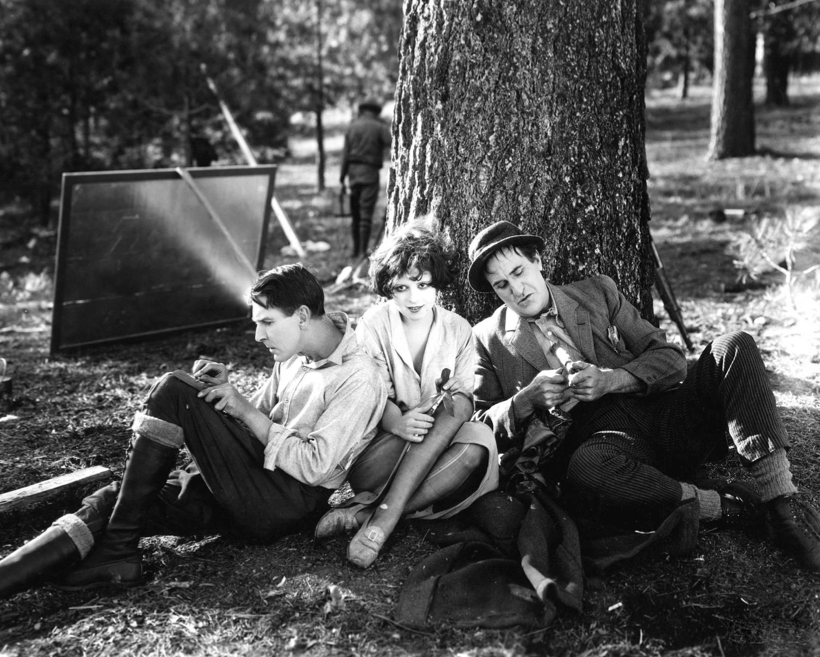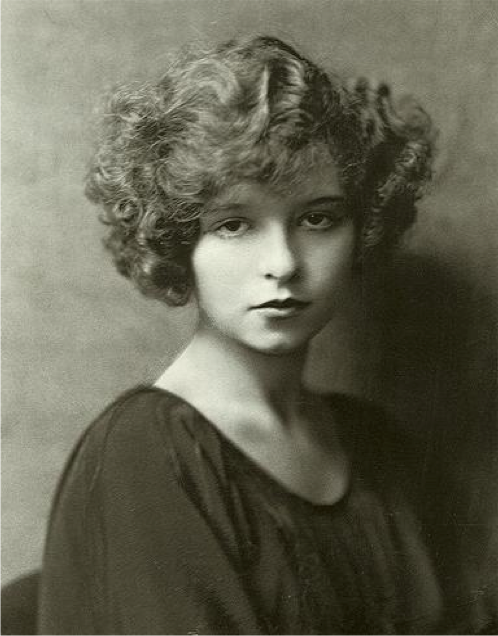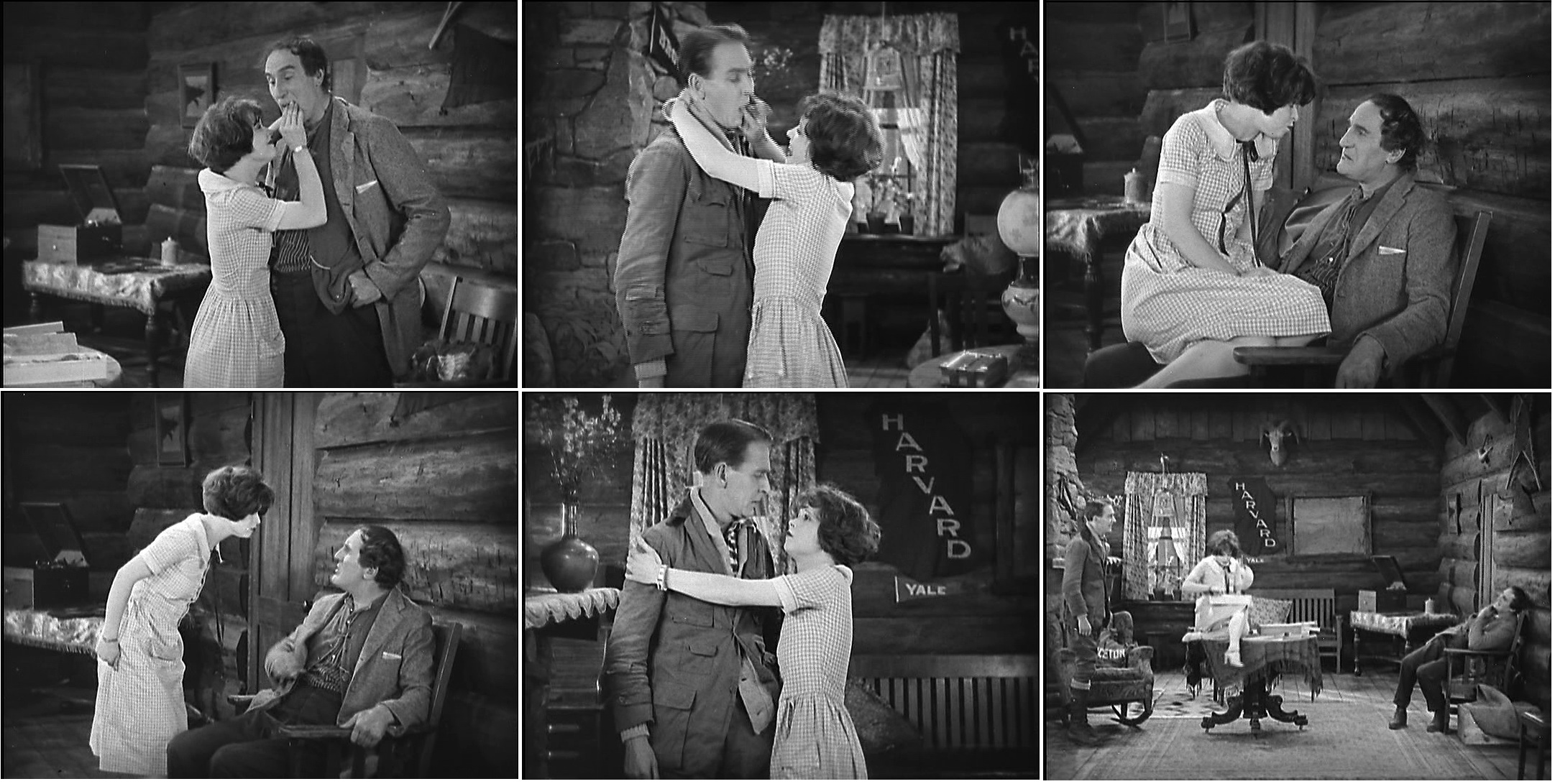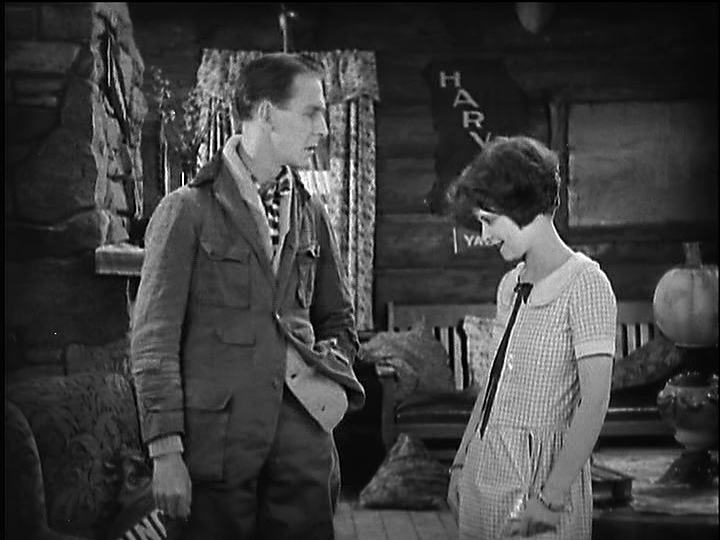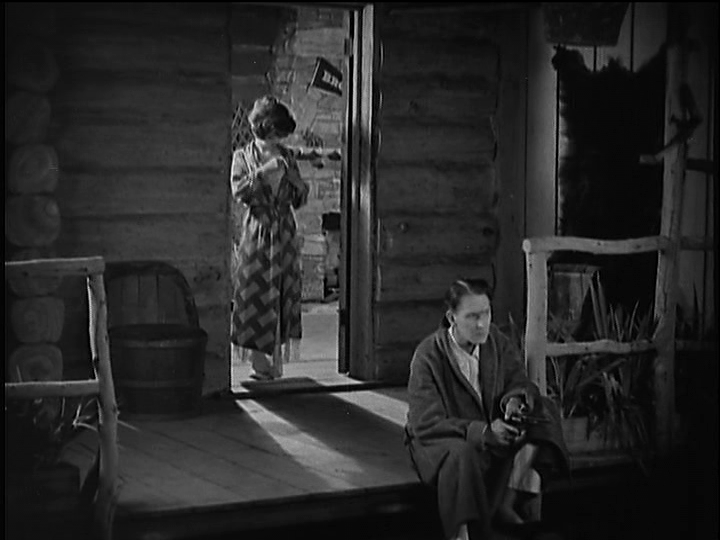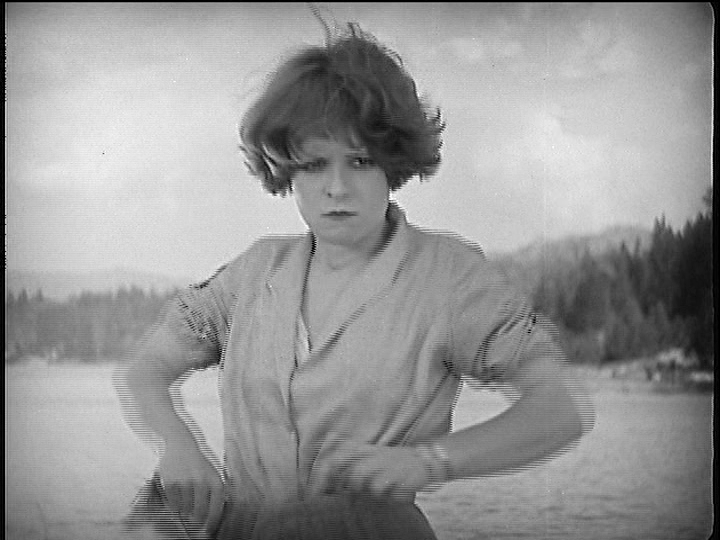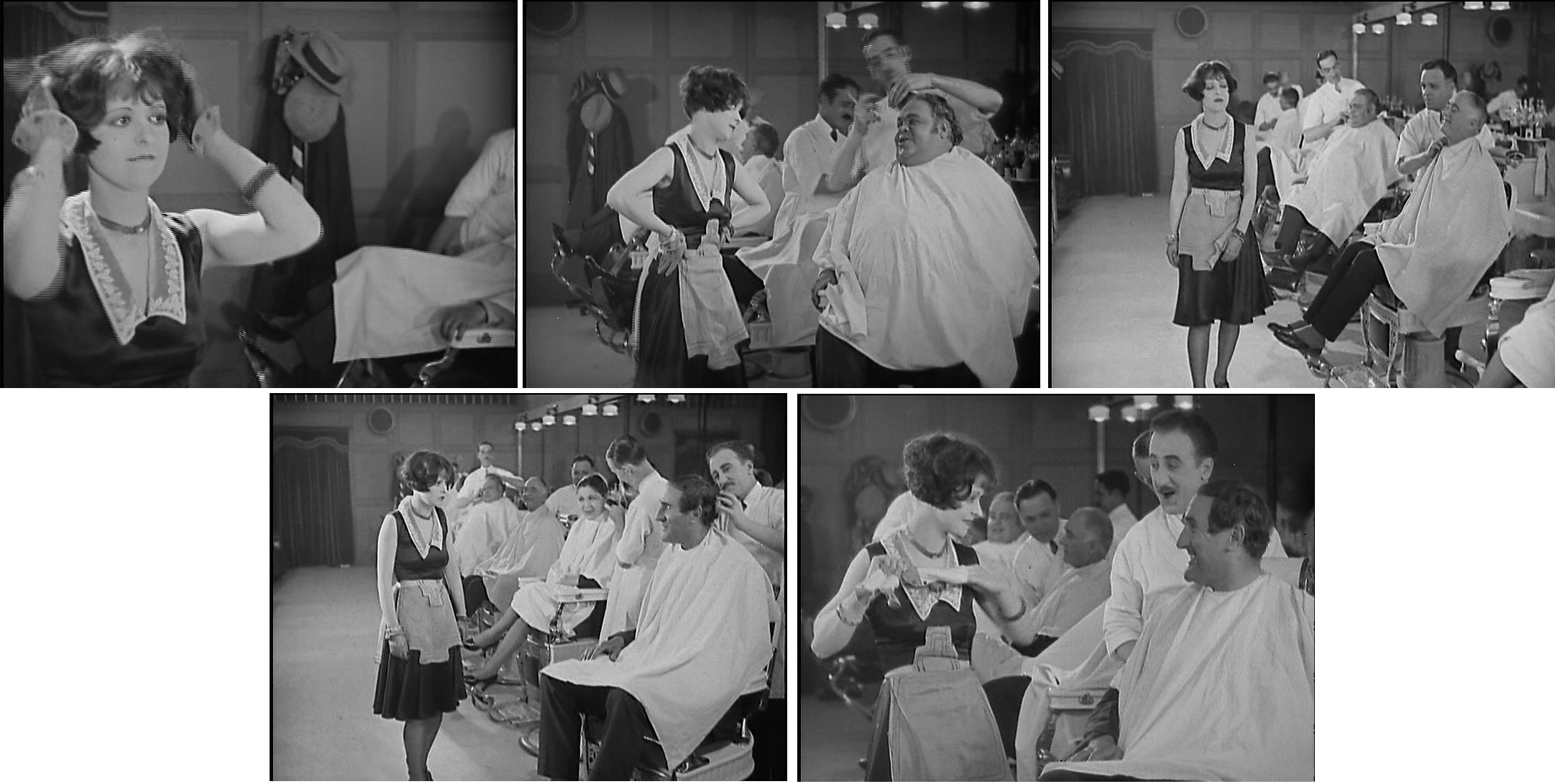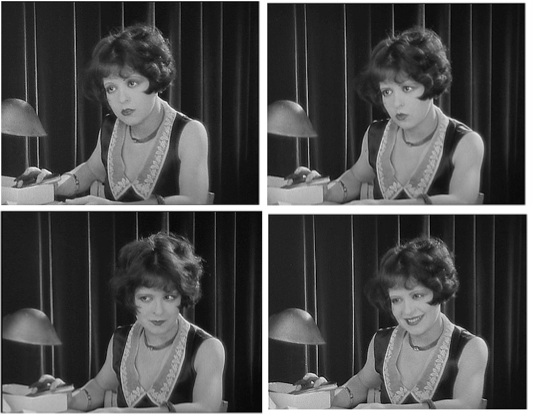Clara Bow in Mantrap
James Naremore
The literature on Clara Bow’s star image and off-screen life greatly overshadows critical discussion of her acting skills, and the reasons why are fairly obvious. She was Hollywood’s first truly modern sex symbol—the iconic Jazz-baby or “It” girl–and her life story, intelligently told in David Stenn’s Clara Bow: Runnin’ Wild (1988), was far more sensational and disturbing than any of her movies. Before examining her work, it may be useful to briefly review the historical and contextual issues.
Born to an abusive father and a mentally disturbed mother who at one point tried to kill her, Bow grew up in a miserably poor Brooklyn ghetto and had only a seventh-grade education. In 1921, at age sixteen, she defied her mother and entered a “Fame and Fortune” contest sponsored by the Brooklyn-based Motion Picture magazine. Like all the other contestants, she was given make up and asked to do nothing more than walk on screen, answer a telephone, laugh, look worried, and look frightened. She was so charming and distinctively individual that more tests were ordered. “The rapidity of her improvement is scarcely credible,” the judges wrote. “She is plastic, quick, alert, young, and lovely . . . her features are photographically excellent” (quoted in Stenn, 18). She won the contest and was immediately sent to professional photographer Nickolas Murray, one of whose portraits of her, never published in Motion Picture, is among the most stunning ever made of an aspiring actor: unsmiling, her youthful face crowned by a billow of Gibson-Girl hair, she gazes at the camera, her eyes half shadowed, looking both sexy and slightly haunted:
In the next year Bow was cast as a supporting player in a couple of East-coast productions, in one of which her work ended up on the cutting room floor. After appearing in Grit (1924, a lost film partly written by F. Scott Fitzgerald), she was brought to Hollywood by B. P. Schulberg, who worked her relentlessly and paid her relatively little. In 1926 she and Schulberg moved to Paramount, where her fortunes began to improve, reaching their height in It and Wings (both 1927). By 1930, at the age of twenty-five, she had made nearly fifty films and was one of the most valuable properties in the industry, the recipient of over eight thousand fan letters a week, as popular with women as with men. She had been repeatedly assigned to light-weight, slightly risqué comedies in which she wore lingerie and danced with suggestive abandon–pictures that established her image as a hyperactive, fun-loving girl who was both forthrightly and avidly sexual. Offscreen, she had affairs with numerous men, including Gilbert Roland, John Gilbert, Gary Cooper, Victor Fleming, and cowboy actor Rex Bell; but her lack of education, her honesty, and her tendency to flirt with anyone she found attractive made her a social pariah in Hollywood.
A talented comic, Bow was an instinctive actor who could improvise brilliantly, often challenging her directors, photographers, and fellow players to keep up with her surprising moves. With the advent of sound, however, her career came to a rapid end. The early talkies were too slowly paced for her mercurial style, and her voice revealed her semi-literate Brooklyn background. She was exhausted from years of overwork, bitter about the formulaic projects she had been given, and beginning to show age. To make matters worse, her gambling debts and sex life became public knowledge. False rumors (later accepted as truth in Kenneth Anger’s Hollywood Babylon) circulated claiming that she slept with the entire U.S.C. football team; and in January, 1931, she became involved in a much-publicized court case involving her former friend and secretary Daisy DeVoe, who gave damning testimony about Bow’s many lovers and extravagant spending. The press fed on the case, much as it had years earlier with Fatty Arbuckle’s trial, and the public turned against Bow. The Jazz Age was ending, the Great Depression had arrived, and Bow was too big a risk for Paramount. The studio refused to cast her in a dramatic role she very much wanted and might have been quite good at: Gary Cooper’s co-star in Mamoulian’s City Streets (1931). Her career was essentially finished.
Of the Clara Bow films I’ve seen, the best by far is one of her early Paramount vehicles, Mantrap (1926), an unusual silent comedy directed by Victor Fleming, photographed by James Wong Howe, and based on a Colliers magazine novella by Sinclair Lewis. I haven’t read the Lewis novella, which is described by some critics as a minor, non-comic story about a sexually voracious woman who ruins men’s lives. The movie, scripted by Adelaide Heilbron and Ethel Doherty with corny yet amusing title cards by George Marion, Jr. (“A shot in the glass is worth two in the abdomen”), is altogether different.
Bow is cast in a working-class role as Alverna, the sexiest manicurist in Minneapolis. Ernest Torrence, best known today as Buster Keaton’s father in Steamboat Bill, Jr. (1928), plays Joe Easter, the owner of a dry-goods store in the far-north hamlet of Mantrap. Weary of “he-man country,” where he deals clumsily with domestic chores and tries unsuccessfully to sell ladies’ hats in his store, Joe decides to visit the city and perhaps meet an attractive woman. One of his first sights in Minneapolis is Alverna’s sheer-stockinged leg emerging from a limousine as she bids good-bye to a rich old man. His lantern jaw drops open. She turns, looks him up and down, and walks into a barber shop. He follows. By the time he gets a haircut, shave, and one of Alverna’s manicures, he’s helplessly enamored. She’s intrigued by his size and bashful manner. “I just love working on a real he man’s hand—for a little change,” she says.
Elsewhere in town, successful divorce lawyer Ralph Prescott (Percy Marmont) is fed up with his gold-digging female clients (“No blonde ever lost a divorce case in this state.”) and plans to escape women by going on a hunting trip in the north woods with his friend Woodbury (Eugene Pallette). When the two inept woodsmen finally arrive in the North Country, they become increasingly frustrated with one another, and during a rainstorm they almost come to blows. Joe Easter happens along, stops the quarrel, and escorts Ralph to the nearby Mantrap so that he can find his way back home. When they arrive in Mantrap, however, we discover that Joe is now married to Alverna, who, when she claps eyes on Ralph, begins aggressively flirting with him. Before long she persuades Ralph to “rescue” her and take her back to the city. Ralph reluctantly agrees. (“You must think of me not as a man but as a means of transportation.”) The couple sneaks away and hikes across country, but midway in the journey their Indian guide abandons them, taking all their food. A handsome aviator, scouting for forest fires, sees their cry for help, and when Alverna turns on her charms he leaves the couple with provisions. Meanwhile, Joe discovers Alverna and Ralph’s departure and comes after them with a shotgun; but when he tracks them down, neither he nor Ralph can summon the desire to shoot it out. Infatuated and exasperated with Alverna, the two men sit on the ground and discuss what to do about her. She reacts with disgust, seizes Joe’s canoe, and paddles off, declaring her independence (“You two birds can fly south”) as she heads back to Minneapolis.
Fade out. Time passes. Ralph returns to his office and happily puts a flower in his lapel before meeting one of his blonde clients. Joe is once again living a lonely life in Mantrap, peeling potatoes in his kitchen. His door opens and Alverna comes in, wearing city finery. They embrace joyfully and she tells him “I was lonesome in the city.” Just then there’s a knock at the door, and Mantrap’s new young Mountie enters. Alverna turns, her eyes growing wide with admiration. “Hold on to me, Joe,” she says. “I’m slipping just a little.”
Baldly summarized, Mantrap may sound like a picture about a fickle, impulsive, potentially dangerous woman who makes men miserable; but Bow’s Alverna is no femme fatale. Compare her with Louise Brooks, another sex symbol of the late 1920s, who incarnated a dangerously seductive eroticism in Pandora’s Box (1928) and Diary of a Lost Girl (1929); or with Jean Harlow, made famous as a languid, promiscuous socialite who nearly destroys two American fliers in Hell’s Angels (1930). Unlike these women, Alverna is a spirited, adorably naughty girl who flits from one man to another but isn’t morally disapproved of, punished, or made an object of male anxiety. Why is she so likeable despite her manipulation of so many men? One reason is that the sex in Mantrap is played for comedy (although it’s hard to imagine such a comedy in today’s supposedly more liberated world). Then, too, we don’t see Alverna committing adultery and can’t be sure that she ever does. A major reason, however, has to do with Bow’s “personality.” In using this term I refer not to what Richard Dyer has called a star image, but to the unique personal eccentricities that give a feeling of individuality to character types. Nearly all the classic Hollywood stars and supporting players were typecast, but, like all of us, they also had distinctive traits—particular faces and bodies, specific mannerisms, styles of walking or gesturing, identifiable ways of speaking or smiling. The size, relative intimacy, and sheer amount of information in motion picture images bring these traits to the fore, creating a kind of dialectic between individual and type. Thus, while Bow is remembered as the flapper type, it was her singularity, plus her intuitive and very real talents as a performer, that made her a star and determined Mantrap’s entire conception of the character she plays.
Among the signal attributes of Bow’s screen personality was what the 1920s called “pep” (precisely the word used to describe her by a University of Chicago student interviewed in the 1929 Payne Fund surveys of young people’s attitude toward movies). Unlike nearly all the sex symbols before and after her, she was seldom posed on screen (as opposed to in still photos) as an unmoving figure of “to-be-looked-at-ness.” Her vivid, somewhat exaggerated gestures and facial expressions, like her body movements, went through swift changes and exuded lively energy. In happy moods she literally jumped for joy and looked as if she were ready to break into a Charleston. (Twice in Mantrap she dances a bit, first in a quick foxtrot and later in a sort of comic Morris dance.) In the 1920s she was also described as “hot” and “wild,” terms that referred not only to her flirtatious face and curvy figure but also to her characters’ evident appetite for sex and party-girl abandon, which sometimes led to dancing on table tops. In Mantrap, her sexual enthusiasm is signaled by her habit of unabashedly looking men up and down, as if measuring them for bed. When Ralph arrives as a guest at Alverna and Joe’s cabin, she leads him to the door, smiling to herself and looking over her shoulder to gaze approvingly at his body. Inside the cabin (decorated incongruously with college pennants from Harvard, Yale, and Princeton), she takes his hat, hangs it on a chair, gives it a little pat, and looks him over again.
Mingled with these characteristics was a slight boyishness, indicated in this picture by her assertiveness, arms-akimbo postures, and forceful stride in the outdoor scenes. Equally important were certain child-like qualities that gave a touch of innocence to her sexiness and made impulsive behavior seem benign. These qualities are especially evident in Mantrap during her interactions with Ernest Torrence. She’s petite and vivacious and he’s hulking and huge; she treats him like a big, gentle pet and gets her way by behaving like a spoiled little girl. When Joe and Ralph first arrive by canoe, she stands waiting on a dock, holding out her arms and jumping for joy in the manner of an excited kid. Inside the cabin, Joe reveals that he has bought her a box of candy. She eagerly takes a piece and chews happily; then she stuffs a piece into Joe’s mouth, patting him on the head and laughing as if she were feeding a faithful dog. Next she skips over to Ralph, places a hand suggestively behind his neck, and stuffs a piece into his mouth. As he chews awkwardly, she smiles knowingly, gives him a little kiss, and ruffles his hair. Turning, she crosses to where Joe is sitting and hops into his lap, chewing candy and offering a suggestion: “Let’s throw a nasty party for Ralph tonight—something to remind him of home.” Joe says they should invite the local Reverend. She hops up, puts her hands on her hips, stomps her foot in childish anger, and slaps him on the shoulder. Then she grabs his lapel and yells at him. (“Gee, you always pick out the worst crumbs in the bakery!”) Joe puts his fingers in his ears and rolls his eyes. Crossing the room, she gets a pillow and throws it at him. Then she goes to Ralph, pouts, and pleads cutely. (“Tell him you don’t want those wet blankets at your party!”) Joe promises her that the respectable guests will leave early. Wildly happy, she embraces Ralph, spins around, and jumps up onto a table top, where she sits eating more candy:
Mantrap was obviously constructed around key aspects of Bows’ established screen personality (and perhaps even the personality Hollywood attributed to her offscreen), but this isn’t to say that she simply projects her “natural self.” She brings certain unique physical qualities and styles of behavior to the role, but her performance also involves technical skill and intelligence at the level of expressive gestures, body movements, and facial reactions. Costuming and hair styling, for example, are especially important elements in any performance by Hollywood sex stars, but few actors have used these accoutrements as wittily as Bow does in the service of movement and gesture. She was regarded as the quintessential flapper, but in Mantrap she never wears the pure flapper clothing style (see the tubular dress and cloche hat on the City Woman in Murnau’s Sunrise [1927]). Her half dozen costumes include silken dresses with short but flared skirts, a gingham frock with pockets, a simple nightdress, and outdoor garb consisting of loose skirt, mannish shirt, and cowgirl hat. In every case she has an ornament or an accessory (necklace, bracelet, gloves, robe, scarf) that facilitates her gestures, or a loose part of her costume (skirt, neckline, pockets) that she fingers or adjusts expressively. Her short hair isn’t a pure 1920s bob–it has waves and curls that she can fluff or play with in the same way as she plays with the costumes. Thus when she spots Ralph approaching Mantrap, she whips out a compact, checks her makeup, and ruffles her hair. (She does this throughout the film whenever she sees a man approaching.) Inside the cabin, while Ralph’s back is turned, she pulls the neckline of her gingham dress down a bit, puts a hand on her hip, and ruffles her hair again:
When Ralph turns to face her, she smiles, saunters over to him, mannishly hooks her thumbs into the pockets of the dress, and looks him up and down:
Late that evening, wearing a nightdress and a robe, she approaches him on the front porch of the cabin by fluffing her hair, tightening her robe, and pulling her neckline down once again:
Still later, in the outdoor scenes, she expresses determination by hooking her thumbs into the elastic waist of her skirt, pulling it up and out from her body and letting it snap back into place:
We can also see a clever use of clothing and accessories in the early barber shop scene, when Alverna enters from a back room and prepares to go to work. Her dark dress has a short skirt and is made of shiny, silken fabric that reveals the shape of her breasts and has something of the flowing, frilly quality memorably described by the poet Robert Herrick as a “wild civility” and “sweet disorder” that “kindles in clothes a wantonness.” Quickly glancing around, she removes her gauzy jacket, chats briefly with a barber, takes a short apron from a rack and ties it confidently around her waist. She walks forward into a brief close up that shows off her softly backlit hair, her milky flesh, and a beauty mark under her left eye. In a wider shot, we become aware of her choker necklace, bare arms, bracelets, and semi-transparent gloves with lacy cuffs. She provocatively bites her lower lip and fluffs her hair with both hands; then she twirls the edge of her hair with a finger and gives a slight under-the-lashes look toward where Joe is sitting. The camera tracks backward as she walks down the line of customers, joking with one, chatting with another, moving with sexual swagger and a hint of street smarts. (Bow seldom moves with an erect posture; her shoulders are relaxed, free and easy.) Then she stops. Pretending to notice Joe for the first time, she looks him over with a curious expression. He shyly smiles. She bites her lower lip again, widens her eyes, and speaks. (“Well, well, a big boy from Away Back.”) Then she lowers her head and looks at him under her lashes, holding the gaze and smiling as she sexily removes her gloves for business:
Bow’s face was every bit as animated and expressive as her movements and gestures. Her radiant skin, Betty-Boop eyes, and Cupid’s-bow mouth were loved by the camera, but equally important she could change very quickly from one vivid emotional attitude to another–an ability that made her well-suited to comedy. In the barber shop scene, for instance, she swiftly goes through a gallery of faces, all amusingly pretty and all somewhat comically overstated. She lets us see that Alverna is putting on an act but also makes the act charming, as if she genuinely likes men and isn’t simply duplicitous. First she approaches Joe with a serious and businesslike air, moving her chair and manicuring bowl up to where he’s getting a haircut, but he pulls his hand away because he’s fearful that he’s too big and crude. Then she becomes maternal and soulful, pouting a little as she takes the hand and gently strokes it. Wide-eyed, with an all-too honest expression and an attitude of confidentiality, she leans in and assures him that she’ll enjoy the job. He consents. She smiles excitedly and scrunches her shoulders in delight, looking him in the eye while resting her hands atop his.
After Joe gets the full treatment from the barber, Alverna leads him over to a manicuring table. The establishing shot shows the two actors facing one another in a 50-50 arrangement and this is followed by shot-reverse-shot close ups. Joe tries to say something but can’t get it out. She makes a genuinely puzzled face. “What?” she softly asks. He awkwardly wonders if she will have dinner with him. She looks exaggeratedly coy, shyly turning her head away. (“Oh I never let men take me out to dinner.”) Turning back to him, she becomes stern and serious, looking him straight in the eye as if to ask what kind of girl he thinks she is. She holds that expression for just a moment (“But you seem so different.”), then smiles and gives him a sweet, sidelong glance:
Bow’s smoothly changing facial expressions and movements are so readable that we hardly need title cards, but are difficult to capture in still images. She occasionally blurs a bit in screen snapshots, and perhaps in that sense can be described as a purely cinematic actor. Lacking a voice, she nevertheless makes the silent screen articulate. I suspect she had more range than was recognized. In her late career she tried to escape the cycle of frenetic, frothy comedies in which she was cast, but was never given an opportunity to show her skill in a well-produced and directed drama. As Mantrap shows, however,she was a compelling personality and one of the most talented and underappreciated comics of the silent era.
James Naremore is Professor Emeritus in the Department of Communication and Culture at Indiana University. He is the author of several books and dozens of essays on film and modern literature, and is the editor of four volumes on film criticism and theory. His most recent book is An Invention without a Future: Essays on Cinema.

